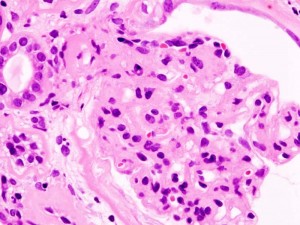Hyperlipidemia in nephrotic syndrome – Mechanism

Diabetes glomerulosclerosis with nephrotic syndrome – histopathology
Click on image for an enlarged view
- Nephrotic syndrome is characterised by albuminuria, hypoalbuminemia, oedema, hyperlipidemia and lipiduria
- The increased loss of proteins in urine stimulates the liver to increase synthesis of proteins
- Apolipoporteins are synthesised in increased quantities – especially apo B, apo C-II, and apo E which are used VLDL and LDL formation
- Apoproteins associated with HDL synthesis – apo A-I and apo A-II usually remains normal
- In addition to this, there is decreased lipid catabolism due to decreased activity of lipoprotein lipase
- All these factors together contribute to the hyperlipidemic state in nephrotic syndrome


